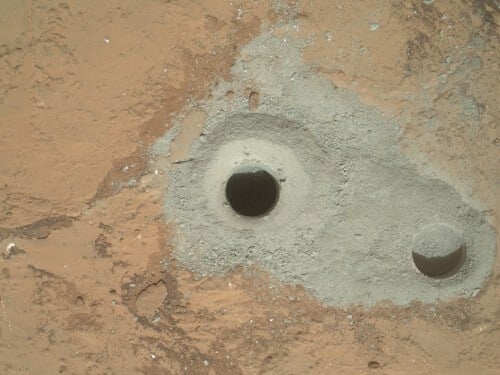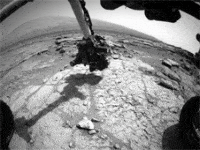Besides the engineering achievement, NASA is being asked to assess whether materials from the period when the environment on Mars was more humid were trapped inside the rock

NASA's Curiosity rover used a drill at the end of its robotic arm to drill into flat, hard rock on Mars to collect a sample of its interior. This is the first time any robot has dug into hard rock on Mars to collect a sample.
"This is the biggest milestone achieved by the Curiosity crew since the sky crane carrying the rover landed on Mars in August 2012," said John Grunsfeld, NASA's assistant administrator for Curiosity Mission Administration. "The most advanced planetary robot now operates the most advanced analytical laboratory on Mars".
The fresh hole, which is about 1.6 centimeters in diameter and 6.4 centimeters deep and sits on a patch of fine-grained sedimentary rock, is visible in images and other data that Curiosity beamed back to Earth on February 9. It is believed that the rock contains evidence of a wet environment that once existed on Mars and is long gone. To test the hypothesis, the researchers will use instruments to analyze the rock powder collected during the drilling.
Over the next few days, the ground controllers will instruct the vehicle arm to perform a series of steps to process the sample, and eventually transfer parts of it to the devices inside the vehicle.
"For the first time, we gave Curiosity an order to drill to the maximum depth, and we believe that we have collected enough material from the rock to meet our requirements for cleaning the equipment and retrieving the sample," says Avi Okon, a mining engineer in charge of drilling at NASA's JPL Jet Propulsion Laboratory in Pasadena, California.
The rock powder passes through a kind of channel inside the drill. Inside the drill there are cells where the powder is stored until it can be transferred to the sample handling mechanisms in the CHIMRA facility inside the vehicle - a facility designed to test Martian rocks and analyze their composition.
Before the powder can be analyzed, part of it will be used to locate remnants of materials that may have remained on the drill from Earth, despite the comprehensive cleaning that was carried out before the launch.
"We will take the powder that we obtained and scrape off the part that is adjacent to the digging coil" explains Scott McCloskey from JPL, an engineer on the drill team. "Then we'll use the arm to transfer the powder from the drill to the shovel, and then we'll have our first chance to see the new specimen."

"Building a vehicle that would interact with unexpected rocks on Mars required ambitious development and testing efforts," says Louise Jandora, Curiosity's sample testing system engineer, also from JPL. "To achieve the ability to drill a hole in a rock on Mars, we did eight drillings in which we dug over 1,200 holes in 20 types of rocks on Earth."
"Within the sample handling system, the powder will be shaken once or twice in a sieve that will sweep out any particles larger than 150 microns. The small pieces will fall through gates on board the vehicle into a device that will test their chemistry and mineralogy, and another device to test samples. These devices will perform the most detailed analysis we are waiting for.
The drilled rock is named John Klein after one of the managers of the Red Planet Science Laboratory mission (the previous name of the mission before it was changed to Curiosity), who died in 2011.

3 תגובות
after the,
Curiosity's First Sample Drilling hole is seen in this image at a rock called "John Klein". The drilling took place on Feb. 8, 2013, or Sol 182 of operations. Several preparatory activities with the drill preceded this operation, including a test that produced the shallower hole on the right two days earlier, but the deeper hole resulted from the first use of the drill for rock sample collection. The image was obtained by Curiosity's Mars Hand Lens Imager (MAHLI). The sample-collection hole is 0.63 inches (1.6 centimeters) in diameter and 2.5 inches (6.4 centimeters) deep. The "mini drill" test hole near it is the same diameter, with a depth of 0.8 inches (2 centimeters).
Can someone explain what is the right hole in the picture and what is the left?
Why destroy why? We came to such a beautiful place, straight to drill holes? to break ? destroy?
Then we wonder if they don't like us.